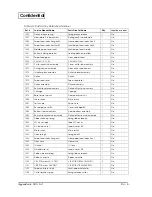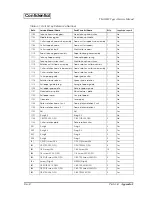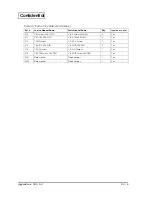
5-8
Adjustment and Setting
Rev. B
Confidential
Note:
The switch functions are shown in the following sections.
US DIP switch functions are slightly different from the STD functions.
STD Tables
Note:
See the tables on the next page when the letters in the illustration above are “US.”
See “Notes for DIP Switch 2-1” on page 5-9 for further information on the settings for DIP SW 2-1.
When you use a serial interface model with 1200 bps, 2400 bps, or 19200 bps, adjust the “serial interface
selection“ DIP switch function and the “serial communication condition“ memory switch.
Serial Model
(DIP Switch 1)
(DIP Switch 2)
SW Function
On
Off
SW Function
On
Off
1
Data receive error
Ignored
Prints “?”
1
Print column selection
42/35
40/33
2
Receive buffer
capacity
40 bytes
4KB
2
Reserved
(autocutter enabled/ disabled)
Fixed to On
—
3
Handshaking
XON/XOFF
DTR/DSR
3
Reserved
—
Fixed to Off
4
Word length
7 bits
8 bits
4
Serial interface selection
Memory
switch
DIP switch
5
Parity check
Yes
No
5
Reserved
—
Fixed to Off
6
Parity selection
Even
Odd
6
Reserved
—
Fixed to Off
7
Transmission speed 4800 bps
9600 bps
7
Pin 6 reset signal
Used
Not used
8
Busy condition
Receive
buffer full
Receive buffer
full or offline
8
Pin 25 reset signal
Used
Not used
Parallel / USB / Ethernet Model (Not for Serial Models)
(DIP Switch 1)
(DIP Switch 2)
SW
Function
On
Off
SW Function
On
Off
1
Auto line feed
Enabled
Disabled
1
Print column selection
42/35
40/33
2
Receive buffer
capacity
40 bytes
4KB
2
Reserved
(Autocutter enabled/
disabled)
Fixed to On
—
3~7 Reserved
—
Fixed to Off
3~7 Reserved
—
Fixed to Off
8
BUSY condition
Receive
buffer full
Receive buffer
full or offline
8
Pin 31 reset signal
Used
Not used
Look at the numbers and letters in the area indicated in
the illustration. If the last letters are “US,” use the “US” tables
on the next page. If the last letters are “STD,” use the “STD”
tables below.
ON
OFF
ON
OFF















































